Our verdict
- Top pick in best running shoes for heel strike pattern (2024)
- Top pick in best running shoes for hiking (2023)
Pros
- Efficient road-to-trail
- Well-cushioned
- Stable ride
- Excellent, secure fit
- Very breathable
- Great traction
- Unexpectedly light
- Reasonably priced
Cons
- Not for muddy areas
- Not for wide feet
- Could be more stylish
Audience verdict
- Top 28% in trail running shoes
- Top 20% in Nike running shoes
Comparison
The most similar running shoes compared
+ + Add a shoe | |||||
|---|---|---|---|---|---|
| Audience score | 88 Great! | 90 Superb! | 90 Superb! | 85 Good! | |
| Price | £130 | £130 | £125 | £150 | |
| Trail terrain | Light | Light | Light | Light | |
| Arch support | Neutral | Neutral | Neutral | Neutral | |
| Weight lab Weight brand | 9.6 oz / 272g 10.4 oz / 295g | 10.1 oz / 286g 10.1 oz / 286g | 9.7 oz / 275g 10.8 oz / 307g | 9.6 oz / 272g 9.6 oz / 272g | |
| Drop lab Drop brand | 12.7 mm 10.0 mm | 9.6 mm 9.5 mm | 11.6 mm 6.0 mm | 10.7 mm 7.0 mm | |
| Strike pattern | Heel | HeelMid/forefoot | Heel | Heel | |
| Size | True to size | True to size | True to size | True to size | |
| Midsole softness | - | Soft | Balanced | Balanced | |
| Difference in midsole softness in cold | - | Normal | Normal | Small | |
| Toebox durability | - | Very good | Good | Decent | |
| Heel padding durability | - | Good | Good | Bad | |
| Outsole durability | - | Good | Good | Good | |
| Breathability | - | Warm | Warm | Moderate | |
| Width / fit | Medium | Medium | Medium | Medium | |
| Toebox width | - | Medium | Medium | Medium | |
| Stiffness | Moderate | Moderate | Moderate | Moderate | |
| Torsional rigidity | Flexible | Moderate | Stiff | Stiff | |
| Heel counter stiffness | Moderate | Stiff | Stiff | Moderate | |
| Lug depth | 3.4 mm | 3.2 mm | 3.3 mm | 2.5 mm | |
| Heel stack lab Heel stack brand | 35.5 mm 36.0 mm | 34.6 mm 37.0 mm | 35.8 mm 30.0 mm | 37.4 mm 41.0 mm | |
| Forefoot lab Forefoot brand | 22.8 mm 26.0 mm | 25.0 mm 27.5 mm | 24.2 mm 24.0 mm | 26.7 mm 34.0 mm | |
| Widths available | Normal | NormalWideX-Wide | Normal | Normal | |
| For heavy runners | ✗ | ✗ | ✗ | ✓ | |
| Season | - | All seasons | All seasons | All seasons | |
| Removable insole | ✓ | ✓ | ✓ | ✓ | |
| Orthotic friendly | ✓ | ✓ | ✓ | ✓ | |
| Ranking | #244 Top 38% | #72 Top 20% | #48 Top 14% | #195 Bottom 47% | |
| Popularity | #197 Top 31% | #48 Top 14% | #191 Bottom 48% | #218 Bottom 40% |
Who should buy
You are sure to benefit from this edition of the Pegasus Trail series if you are after the following:
- a top-in-class running shoe for tackling various types of terrain (except mud)
- a cushioned road-to-trail shoe for going long distances
This trainer will suit both entry-level and advanced runners.

Who should NOT buy
Despite a significant improvement of traction in the outsole, the Trail 4 is still not the shoe to go for if you run on loose or wet trails a lot. It is a big NO-NO for soggy muddy winter trails.
For that purpose, we deem shoes like Altra Lone Peak 7, Salomon Speedcross 6, or Saucony Peregrine 13 better for you.
Cushioning
Shock absorption
The Peg Trail is clearly following the market trend of adding more cushioning with each update, and version 4 proves it loud and clear. It delivers a massive 134 SA in the heel—unthinkable just a few years ago.
On the flip side, the forefoot stays more grounded with just 96 SA, offering a better feel for the terrain up front.

| Pegasus Trail 4 | 134 SA |
| Average | 122 SA |
Energy return
Using React instead of a basic EVA brings improved responsiveness, but nothing that truly stands out. We measured 54.6% in the heel and 58.6% in the forefoot.
| Pegasus Trail 4 | 54.6% |
| Average | 55.6% |
Heel stack
The shoe has a significantly thicker midsole too. Based on the official stats, its heel height of 36 mm is a few millimetres taller than the average across trail shoes.
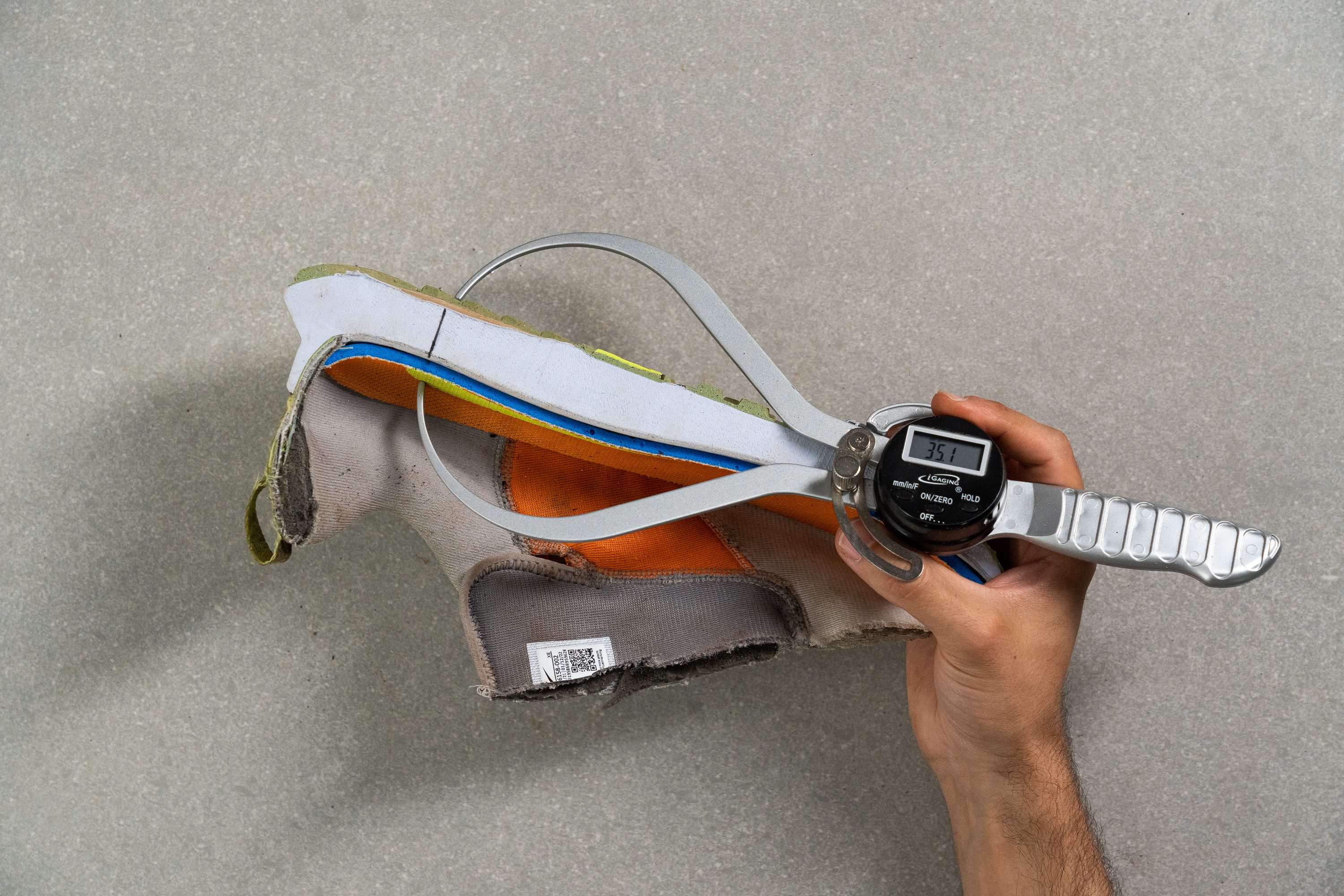
Our own calliper measurement showed just a tiny (0.5 mm) deviation from that stack height at 35.5 mm.

| Pegasus Trail 4 | 35.5 mm |
| Average | 32.6 mm |
Forefoot stack
In the forefoot, however, we found a much bigger discrepancy between the official stack (26 mm) and our measured one (22.8 mm).
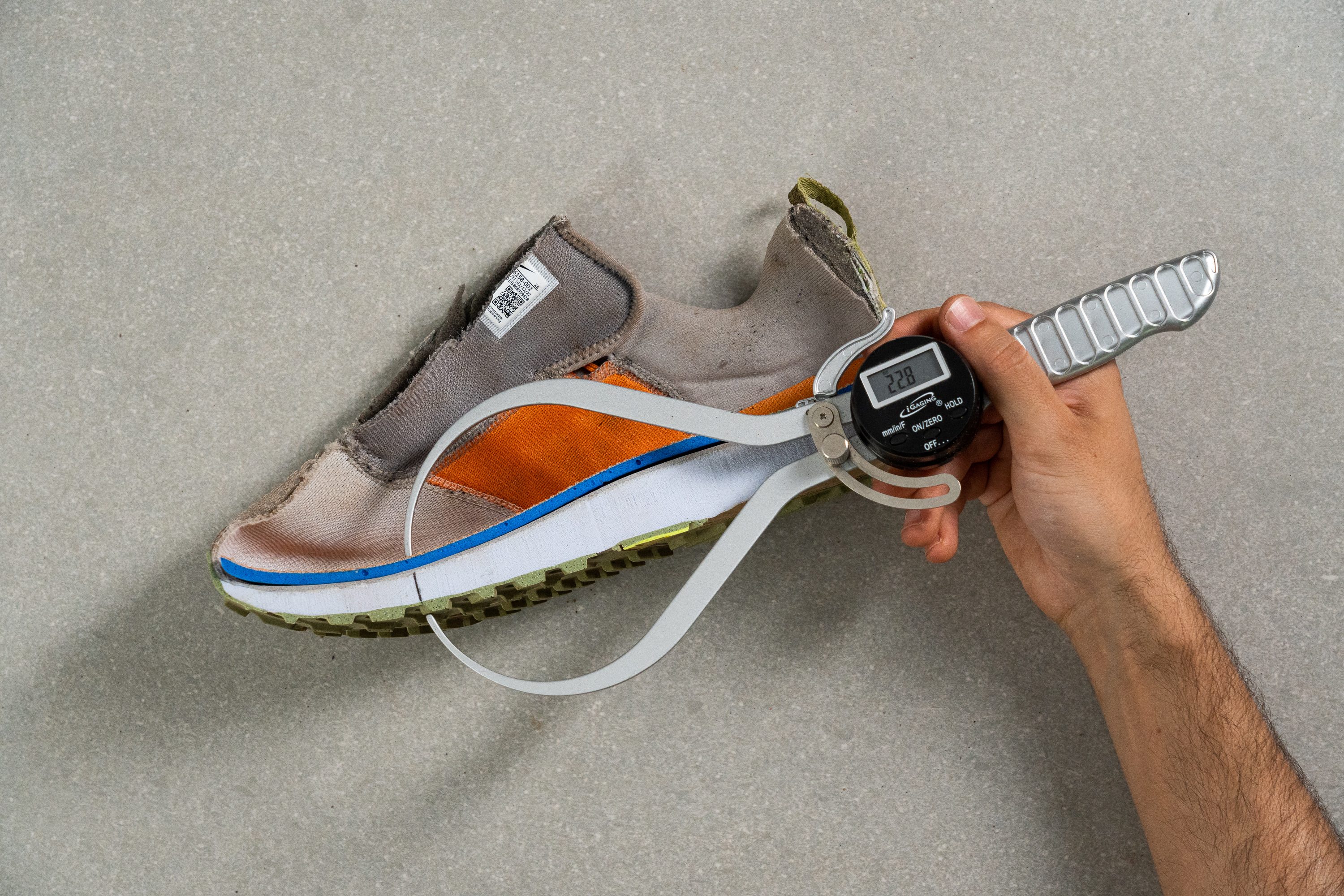
| Pegasus Trail 4 | 22.8 mm |
| Average | 25.1 mm |
Drop
Because of the deviation we discovered in the shoe's stack height measurements, the Pegasus Trail 4's actual drop ended up being 12.7 mm! Not the claimed 10 mm.

Some runners may find the higher heel drop problematic as it activates leg and foot muscles in a different way. Watch out!
If you are not even sure what drop is and which one is right for your body, see our in-depth guide on the drop.
| Pegasus Trail 4 | 12.7 mm |
| Average | 7.6 mm |
Midsole softness
The Nike Pegasus Trail 4 felt quite brisk and responsive on the hard surfaces yet firm enough to feel planted on the trails.
Our durometer measurements show 34.0 HA, which is 20% firmer than the average trail shoe. It belongs to the moderately firm cushioning types but there is still some softness present to make it a perfect option for switching from road to trail.

Ride
Based on our run tests, in the Pegasus Trail 4, the shoe is equally at home on the asphalt and on the trails. It's got the best of both worlds!
Speaking more specifically about the shoe’s performance on different types of terrain:
1. On asphalt, bike paths, and tarmac the ride is pretty energetic with lugs never getting in the way. It even felt almost like a dedicated road shoe!
2. If you happen to run on gravel and similar terrain, the Pegasus Trail 4 really really comes alive on these! The shoe's forefoot lugs grabbed very well running both up and down the hill.
3. On a single track, and more technical and rocky terrain, it's a mixed bag. Because the shoe's cushioning is nothing like the Speedgoat where tonnes of cushioning keeps you protected, we had to pick our lines and tiptoe the way at times. But on the other hand, the Pegasus Trail 4 still performed a lot better than any other Nike trail shoe.
Size and fit
We've had absolutely no problems with the fit of this Nike trail shoe. It feels perfect straight from the box with no rubbing, hot spots, or irritation.
We were especially intrigued by the combination of the well-positioned gusseted tongue and the Flywire cables around the laces. These have kept the midfoot very well-held.
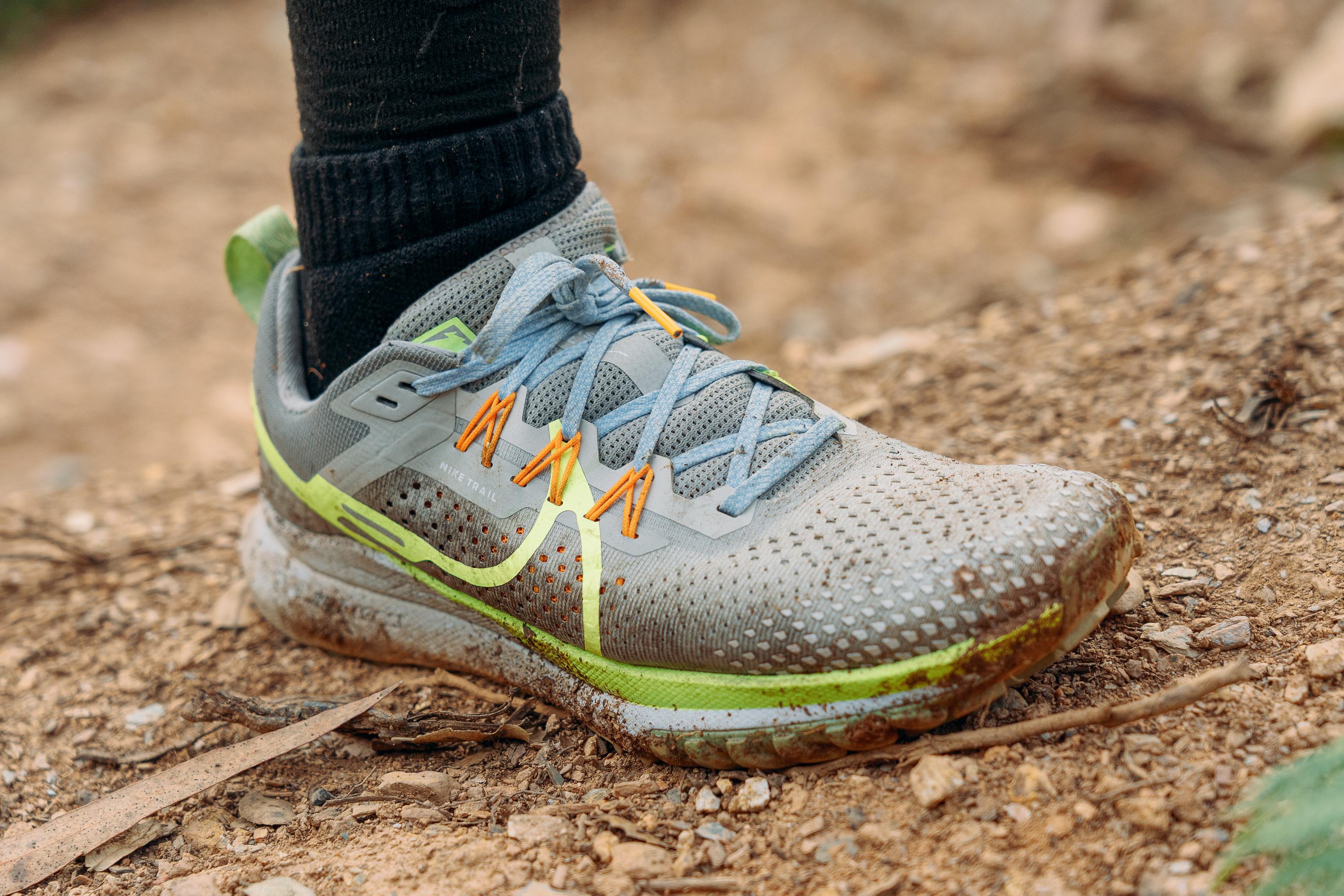
Size
Nike Pegasus Trail 4 fits true to size (200 votes).
Width / Fit
As for the toebox, it’s not the widest shoe in the world but it never felt constricting either. The Trail 4 does have a slightly shallower toebox compared to Trail 3 but it never caused problems to our medium-width feet.
Measuring the shoe's toebox in the widest part, our caliper showed 100.4 mm which is even a couple of millimeters wider than average.

This test follows an older methodology, which is why you don't see recently tested shoes in the chart. Results from different methodologies can not be compared.
| Pegasus Trail 4 | 100.4 mm |
| Average | 98.9 mm |
Traction / Grip
Forefoot traction
We tested the traction of the Pegasus Trail 4 using our SATRA TM144 machine, and the outcome was underwhelming. It posted a disappointing 0.22, placing it among the weakest scores we’ve recorded and making it only suited for easy terrain and dry conditions.
| Pegasus Trail 4 | |
| Average | 0.60 |
Lug depth
The updated tread pattern on the Nike React Pegasus Trail 4 has 3.4 mm lugs which is right at the average of all our lab-tested shoes. Such lug depth is considered quite optimal for a hybrid (road-to-trail shoe).
Even though it’s nearly identical to the 3.3 mm lugs on the Trail 3 version, the 4th iteration has a totally new approach. It now has three different types of lugs which are much sharper.
We found that the Trail 3 really struggled with grip, especially on wet surfaces. We ended up slipping and falling on a wet rock! But this is not the case with the Trail 4.

It is still NOT the shoe for crazy off-trail stretches but it is fantastic for hard-packed, gravely, and rooty types of trails.
| Pegasus Trail 4 | 3.4 mm |
| Average | 3.5 mm |
Outsole design
The outsole of the Pegasus Trail 4 is almost fully covered in rubber, following a one-piece construction typical of road-to-trail hybrids. It features diagonal grooves at the heel and a series of V-shaped patterns under the forefoot. The design includes minimal segmentation and lacks deep flex grooves.
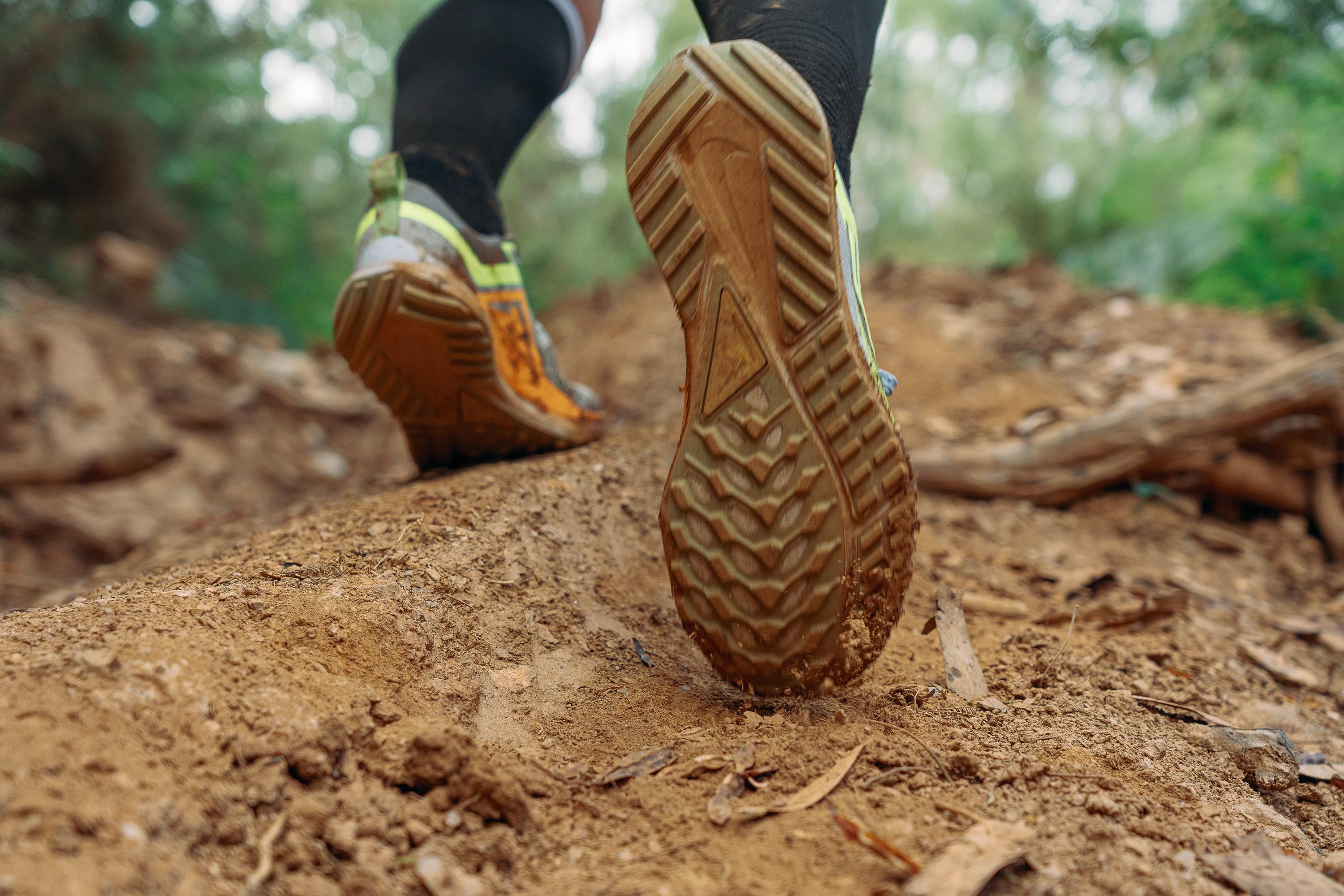
Flexibility / Stiffness
When it comes to heel-to-toe transitions, we found the Pegasus Trail 4 to be pleasantly flexible.
Having performed our force gauge test, we found that it took 10.7N of force to bend this Nike shoe to a 30-degree angle. That is notably less than the average trail shoe!
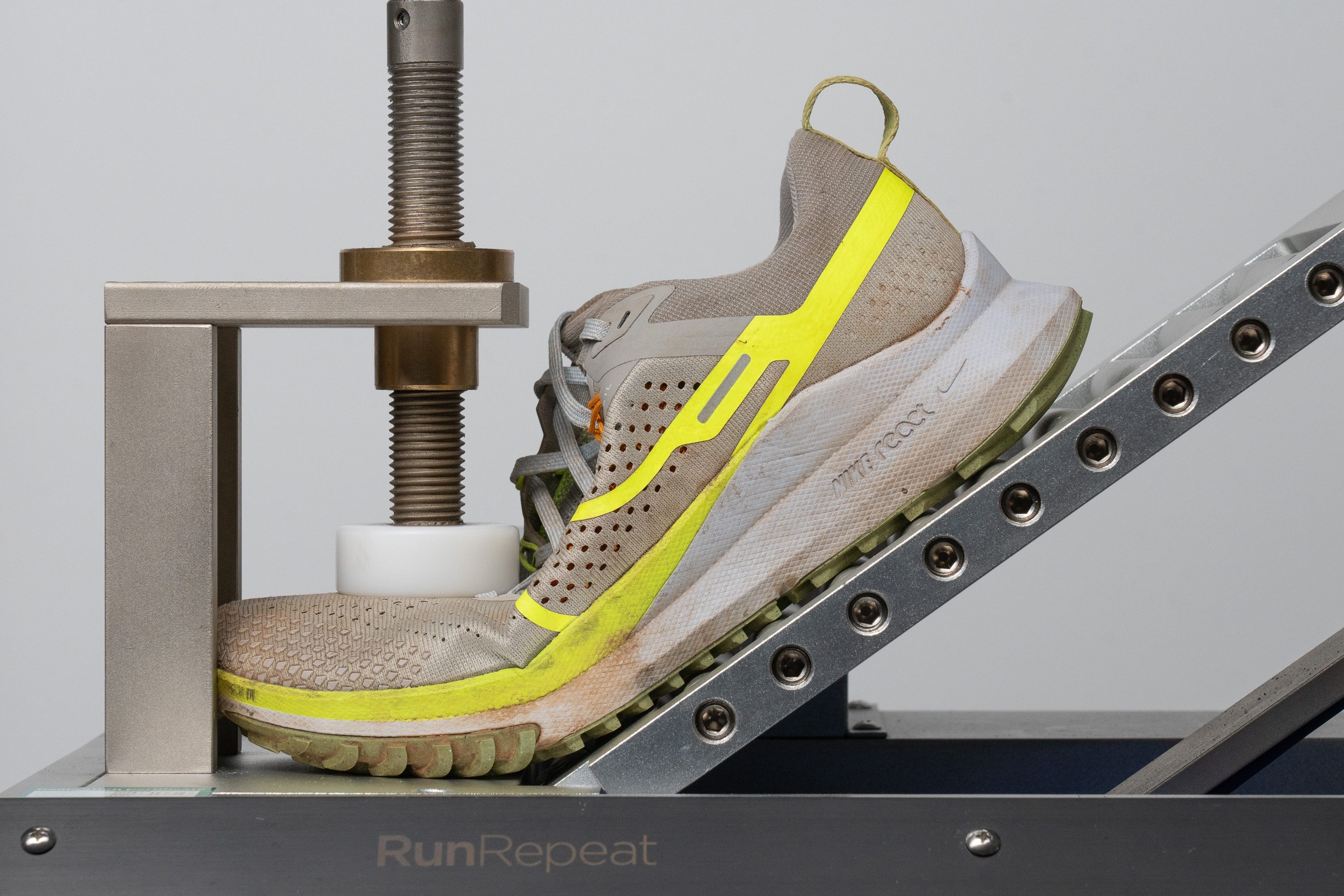
| Pegasus Trail 4 | 10.7N |
| Average | 14.6N |
Weight
The newer version manages to get lighter while also enhancing its overall performance.
The Pegasus Trail 4 weighs 9.6 oz (272g) in a men’s US 9. This is noticeably lighter than the average weight of trail shoes of similar stack height (35 mm and thicker), which is 10.3 oz (291g).
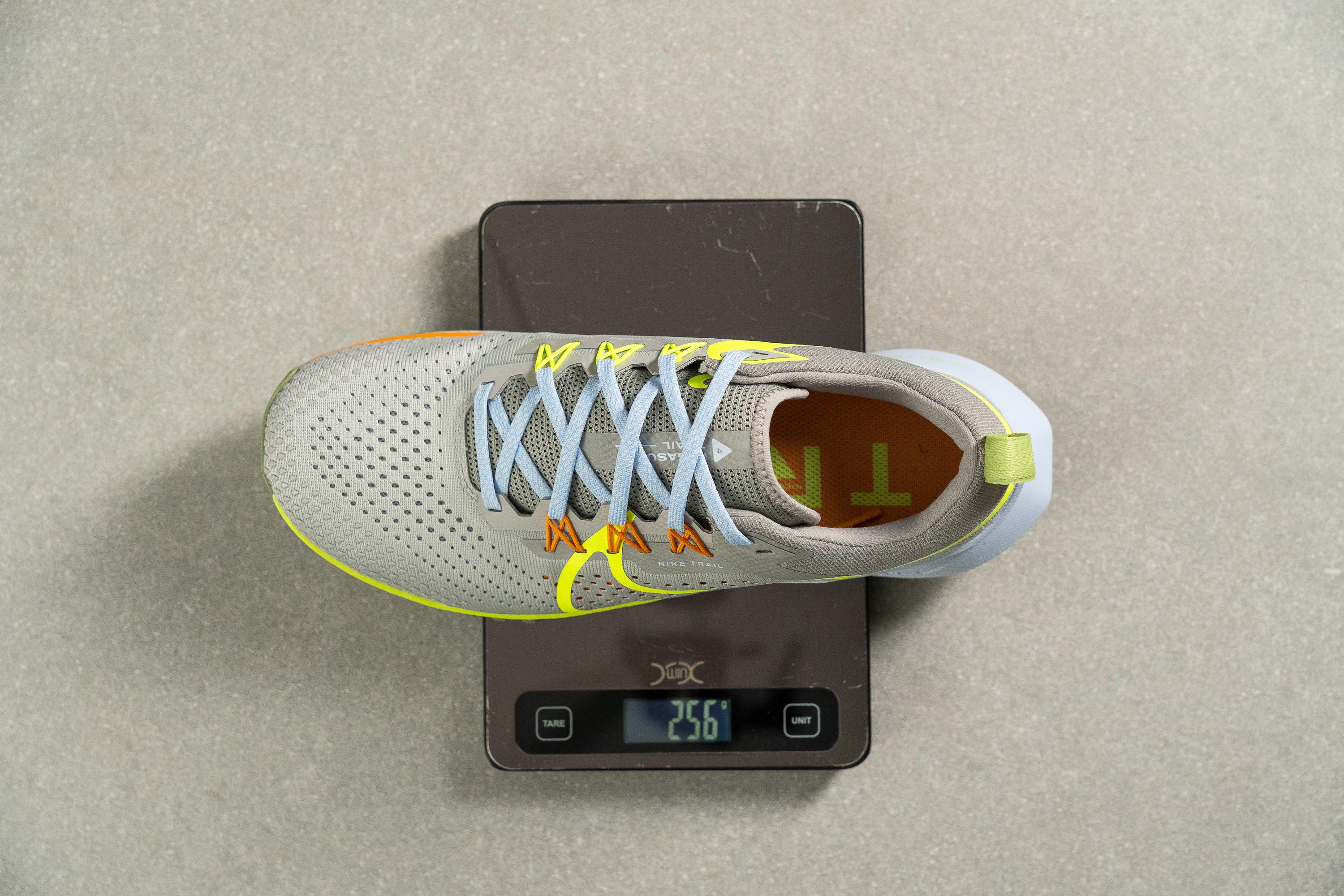
Running up those hills, we highly appreciated the lightness of the Trail 4. The shoe felt a lot like an extension of your foot. Not many trail shoes with this much cushion and such a reliable grip manage to keep their weight as low as this Nike Pegasus did.
| Pegasus Trail 4 | 9.6 oz (272g) |
| Average | 10.2 oz (289g) |
Breathability
The upper of the Pegasus Trail 4 has plenty of perforations all throughout the upper and the tongue. These keep the interiors nice and cool even in the hotter and humid months.
Testing the shoe on a warm day in June, we had a chance to check it for ourselves and it’s indeed very well-ventilated.
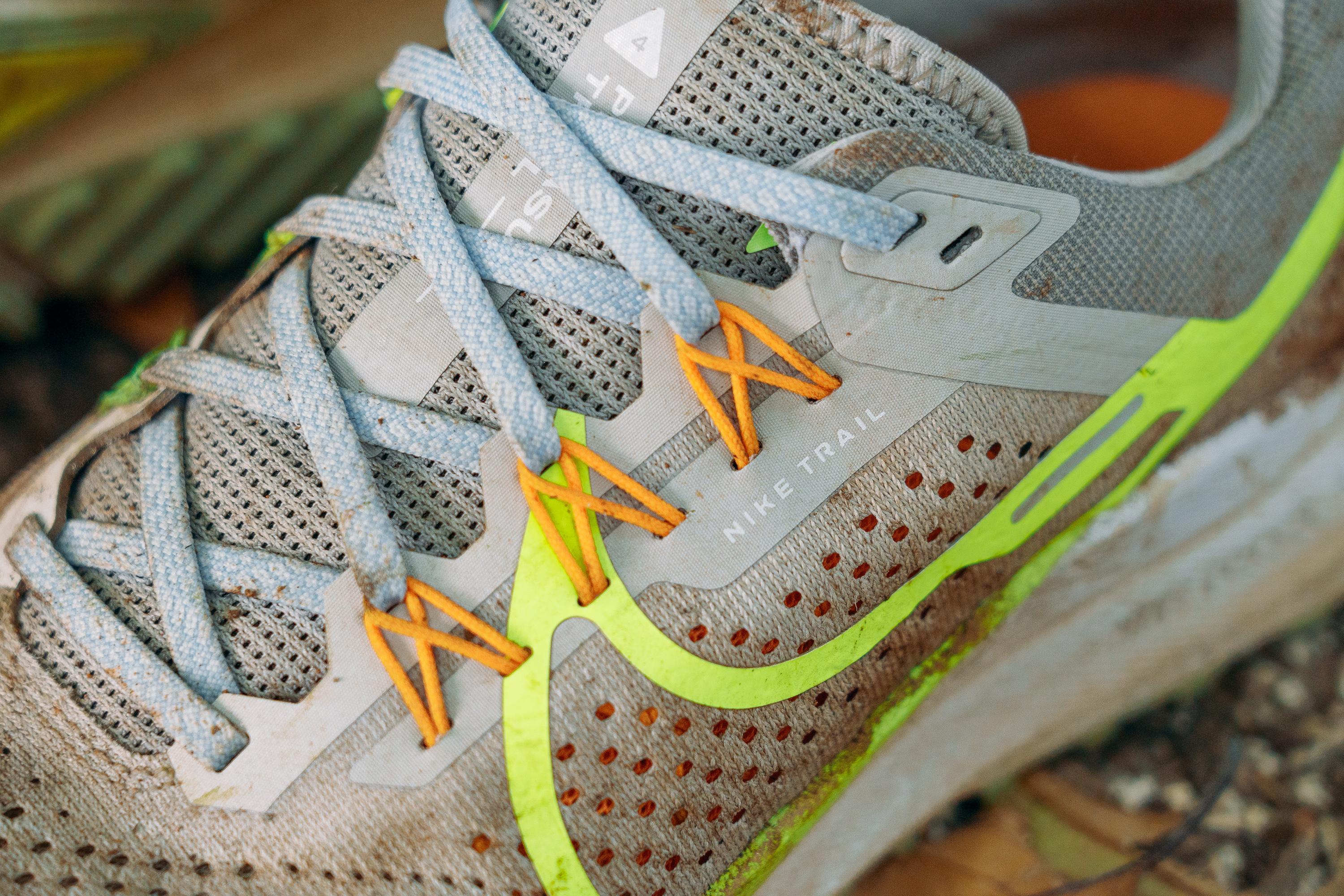
Stability
Lateral stability test
We couldn't help but notice how stable this Nike shoe is, especially compared to its predecessor. The Pegasus Trail 3 felt too soft and high for a trail shoe, whereas the Trail 4 feels closer and more connected to the ground.
We attribute the shoe’s stability to several characteristics: the well-balanced React foam itself, the extended edges of the foam that cradle the bottom of the upper, and the secure upper lockdown which doesn’t let the foot shift inside the shoe.
Torsional rigidity
What does NOT help the Nike Pegasus Trail 4 feel stable is its lack of torsional rigidity (which is totally expected from a neutral shoe by the way!).
Twisting the shoe in our hands, we found that it yielded quite easily and was very pliable. Thus, we gave it a score of only 2 out of 5, where 5 is the stiffest.
| Pegasus Trail 4 | 2 |
| Average | 3.6 |
Heel counter stiffness
We really appreciated the shoe's sturdy and well-structured heel cup. Checking it in our lab, we gave it 3 out of 5 in our heel stiffness test. No heel slippage in this one.
| Pegasus Trail 4 | 3 |
| Average | 3 |
Midsole width - forefoot
The Nike Pegasus Trail 4's platform is not so wide... While it was a huge benefit for the shoe's lightness and agility, it felt very different from the broad trail shoe bases we've come to expect.
In the widest part of the forefoot, our calliper showed 107.1 mm. That is 4 mm narrower than average.

| Pegasus Trail 4 | 107.1 mm |
| Average | 112.8 mm |
Midsole width - heel
Back in the heel, we got 85.4 mm in the widest part of the sole. This is, again, about 4 mm narrower than average.

| Pegasus Trail 4 | 85.4 mm |
| Average | 89.8 mm |
Misc
Insole thickness
Added cushioning is provided by a well-padded insole. It is 4.2 mm thick compared to the average 4.6 mm. The insole is removable and can be easily replaced with custom orthotics if necessary.
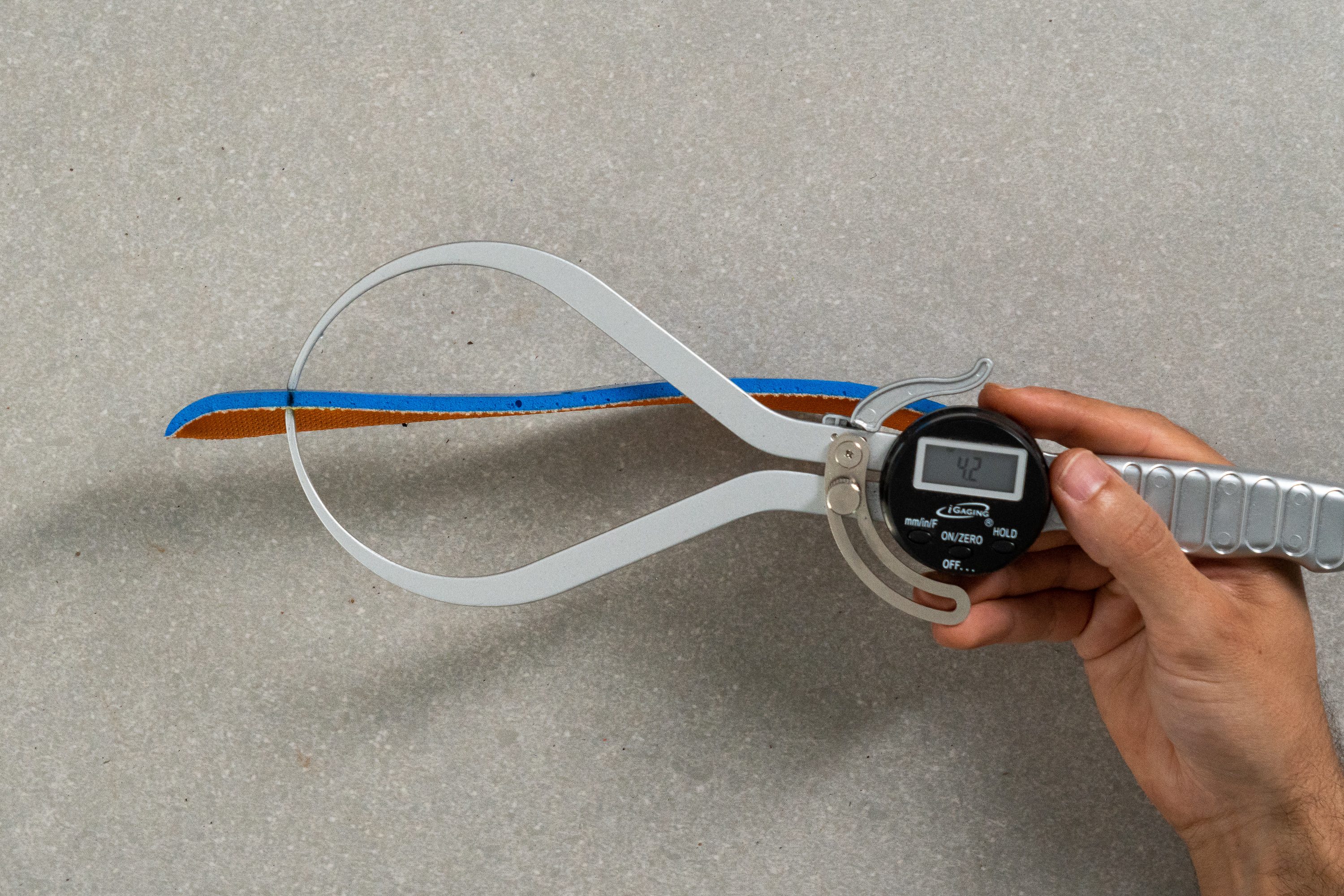
| Pegasus Trail 4 | 4.2 mm |
| Average | 4.7 mm |
Tongue padding
The shoe’s interiors have just enough padding to make it feel nice and plush. For example, we have measured the tongue thickness at 5.3 mm which is just a little below the average 6 mm.
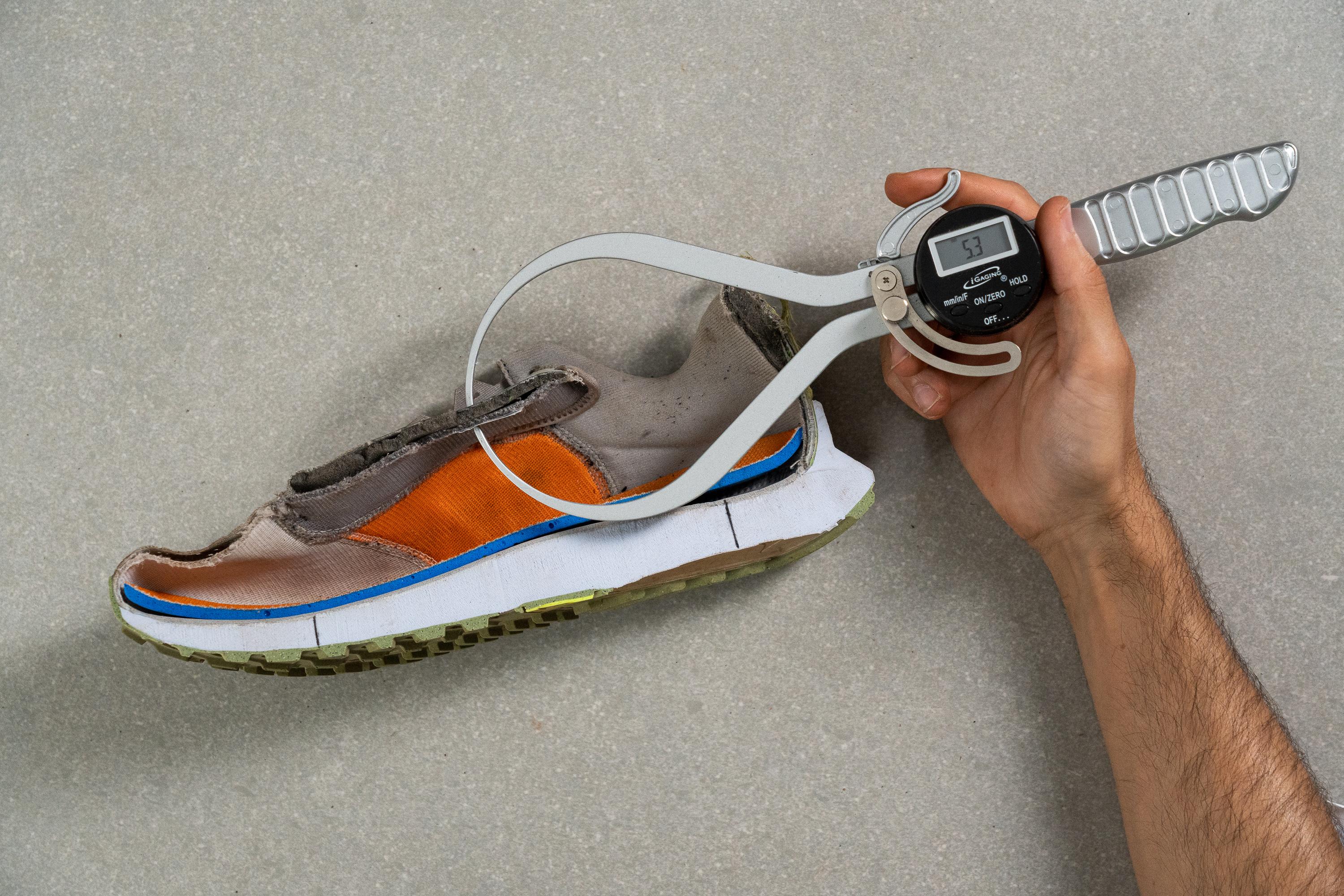
| Pegasus Trail 4 | 5.3 mm |
| Average | 6.4 mm |
Nike Pegasus Trail 4 vs. Trail 3: a major overhaul
With all the changes introduced in the Trail 4, it is almost a new shoe from the ground up. Here are the key upgrades:
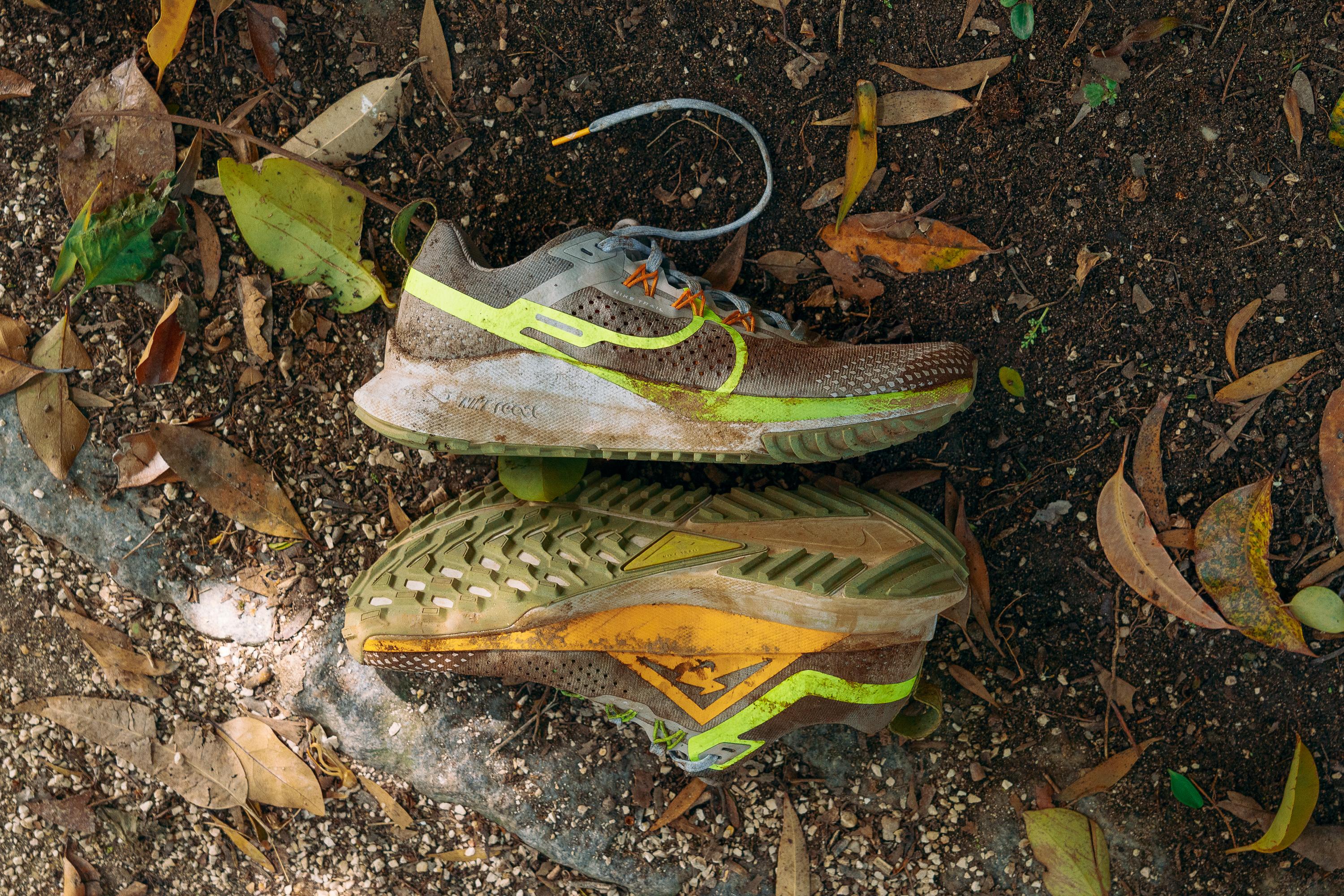
- 8% lighter: (295 g vs 320 g)
- better grip from the new tread design
- more secure hold with added Flywire cables
- less spacious toebox, more like a glove
- £10 increase in the price
- more toned-down visual design
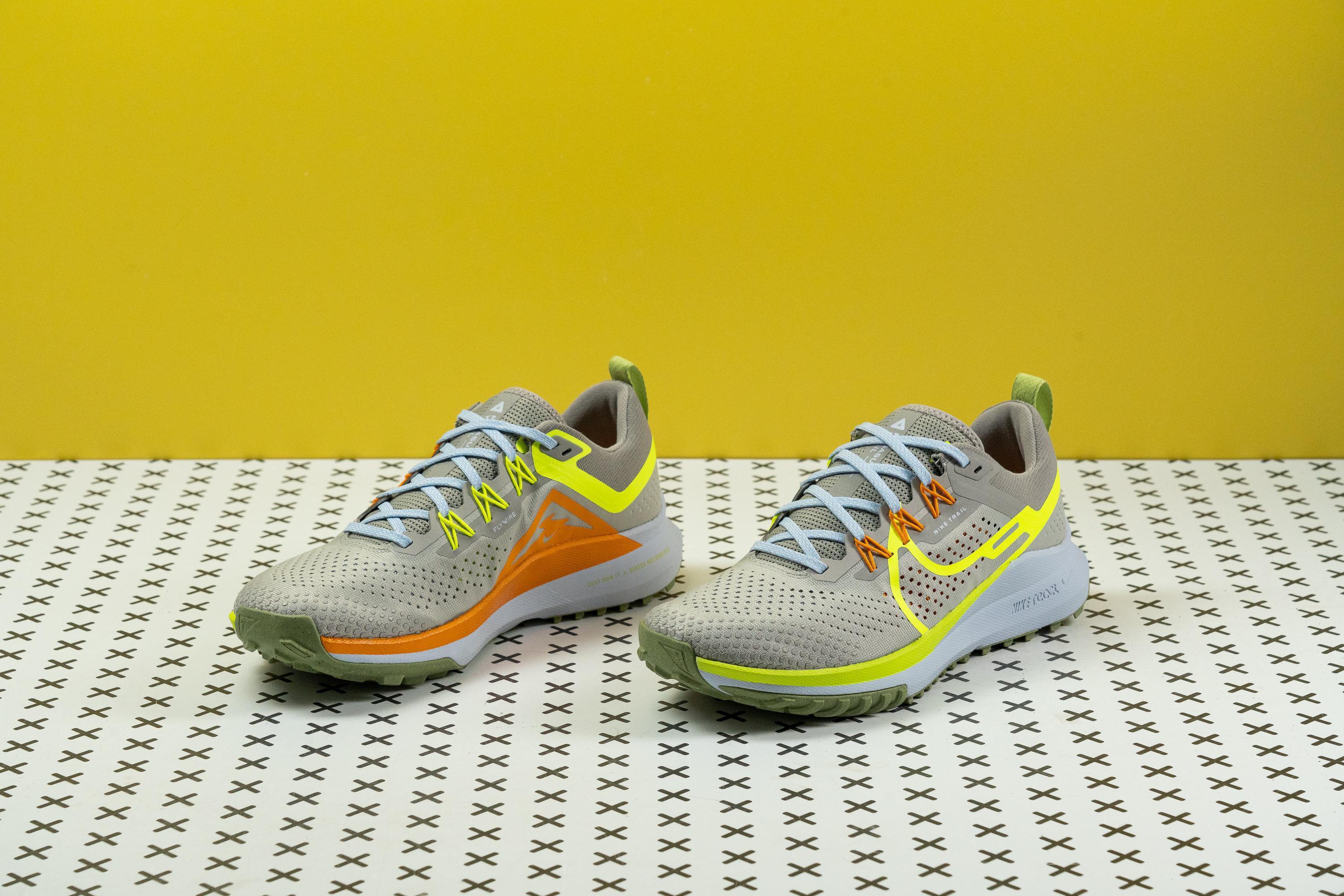
Despite the slight £10 increase in its asking price compared to the Trail 3, we still consider the Pegasus Trail 4 a reasonably priced one at £140.
For reference, the average price of trail shoes is £150. But, if we are talking about the max-cushioned, super grippy ones (£170 on average), then £140 is hitting the bull’s eye.


































